The Tour de Ski is the ultimate test of endurance, pushing athletes to their physical and mental limits, with few other events demanding such frequent back-to-back competitions. Yesterday’s individual start 20 kilometer freestyle competition was a grueling marathon effort, with racers battling for the climb leader position at the 10 kilometer checkpoint while navigating a course that offered little opportunity for recovery.
To follow that up today, the challenge continued with a 15 kilometer classic pursuit race, with start intervals determined by yesterday’s 20 kilometer freestyle competition. Unlike some stages, no bonus seconds were awarded for this stage, and instead, the time differences between athletes directly influenced the adjustments to the overall Tour de Ski rankings. This made every second on the course important, as the time gap to the leader was just as significant as the finishing position for each athlete.
Although skiers left the start gate in a staggered format, the results were determined by the first to cross the finish line, making the pursuit style especially challenging for athletes who excel in classic distance disciplines but struggled in the previous day’s freestyle competition. This may have been the case for Norway’s Erik Valnes, a strong sprinter and distance racer with multiple podiums to his name in the 15 kilometer classic discipline. Today, he skied to the second fastest overall time and gained over a minute on the leaders, though still finished 12th on the results list.
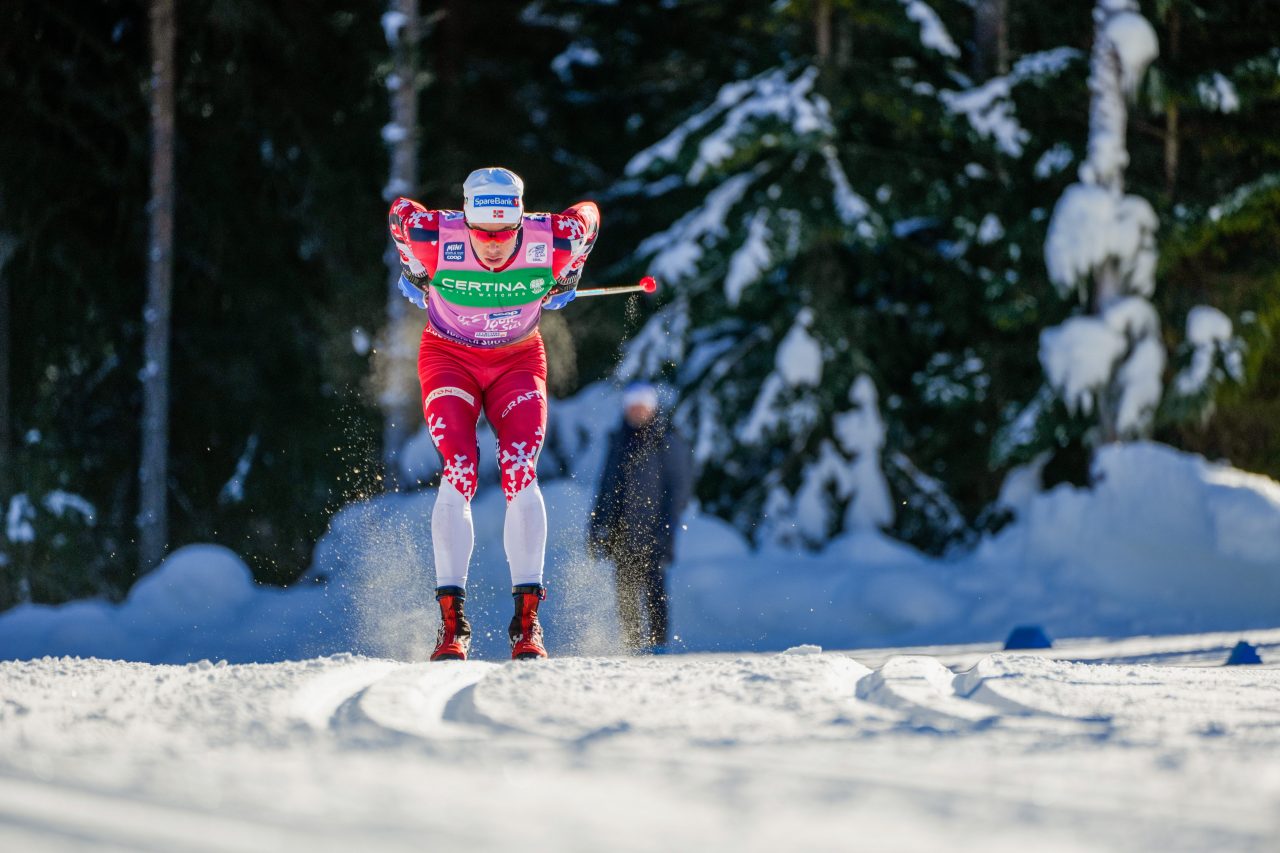
The pursuit format placed Harald Oestberg Amundsen (NOR) first out of the gate, holding a 21.2 second lead over teammate Simon Hegstad Krueger (NOR) and a 28.4 second advantage over Andrew Musgrave (GBR). With many athletes eyeing the podium, spectators held their breath to see who might close the gap to Amundsen and challenge for the top positions. Johannes Hoesflot Klaebo (NOR), the overall Tour de Ski leader, started in fifth, 46.4 seconds back from Amundsen. Known for his ability to dominate both distance and sprint races, the question lingered: could Klaebo close that gap and maintain his standing as overall leader?
He came close. Klaebo finished just 5.3 seconds behind Amundsen in third place, narrowly edged out of second by Edvin Anger (SWE), who outpaced Klaebo over the final ascent. With little time back from the victor, Klaebo did, in fact, succeed in maintaining his position as the overall Tour leader. He will continue to wear the yellow bib going into Friday’s competition with a lead of just 36 seconds over Anger and 57 seconds over Amundsen in the overall Tour de Ski rankings. Amundsen has made back time with his wins the past two days, but will need to continue to gain seconds back in the following competitions to compete for the overall leader position
“It was maybe the hardest race I’ve ever done,” Amundsen shared following the competition. “After I started in the beginning, I tried to have some energy until the end, but I heard the other guys were closing in. The last time I managed to increase a bit, but the last two kilometers I was totally dead.”
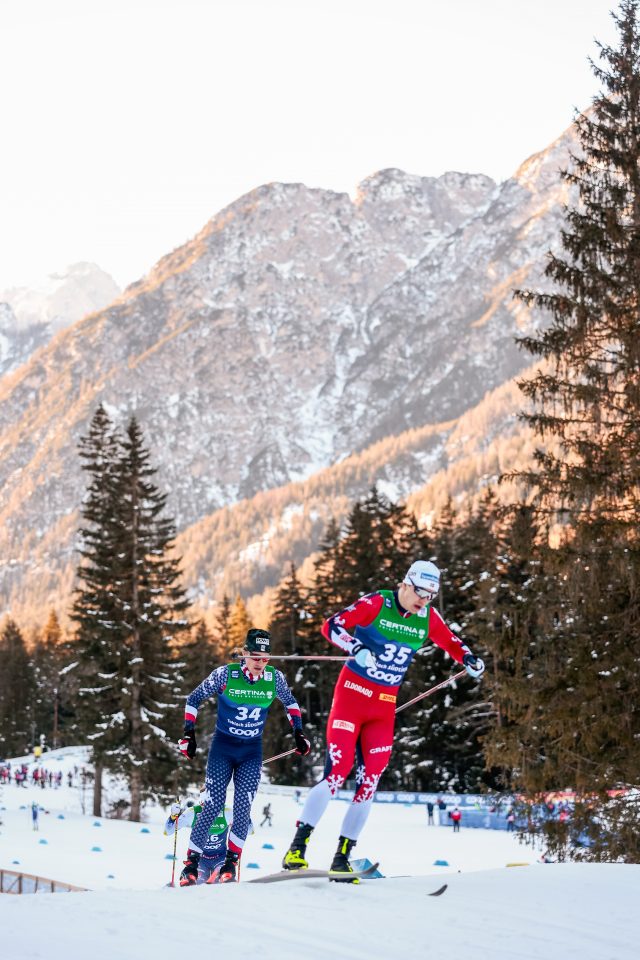
Gus Schumacher (USA) was happy with his result, starting the day in 34th, and climbing to finish the pursuit in 17th, making up over a minute on the leaders. “I felt pretty good,” Schumacher said. “I was excited to claw some time back, which will help with my overall Tour ranking. I’m definitely feeling better now than I was 20 hours ago. Much better skis today, and that made a world of difference. It was nice to ski with some fast boys today. Overall, it wasn’t a super taxing race physically or mentally, which is a relief at this point in the Tour.” After today, Schumacher is now ranked 10th overall in the Tour de Ski standings.
Last year, Ben Ogden (USA) had high hopes of finishing the Tour in the Points Leader Bib but was forced to withdraw after falling ill while sitting third overall. This year, Ogden started Stage 4 determined to make up for last year’s disappointment, beginning the race 9th and starting 59.4 seconds back from the leader. Still ranked 3rd overall in the Tour before today’s race, Ogden would need to make up time or positions to maintain his ranking.
However, it wasn’t his day. Ogden broke a pole just 1.5 kilometers into the race, struggling to find his rhythm again after that. “I felt pretty frustrated with today,” Ogden shared. “It just feels like deja vu from previous years, where I get excited with a strong start and then immediately take myself out of contention in one race.”
The broken pole forced Ogden to push hard early, a strategy that took its toll. “The first 1.5 kilometers with a broken pole and the following minutes of frustration were brutal. I went extremely hard early, which made it very difficult to hang on to any of the packs that caught me. I started to recover toward the end, but by then, the damage was done.” He concluded, “that’s the nature of the beast, but it’s still frustrating.” Ogden finished 22nd, losing over a minute to Amundsen and dropping to 17th in the overall Tour standings.
Other Americans Zanden McMullen finished in 48th, JC Schoonmaker in 55th, and Jack Young in 76th. Canadian skiers had a strong day with Antoine Cyr in 27th and Olivier Leveille finishing 42nd.
Men’s 15-kilometer Classic Pursuit
The men’s field set out under a clear Toblach sky, with sunlight filtering through the trees casting long shadows on the freshly groomed trails. The 15 kilometer classic pursuit sent racers to tackle three laps of a 5 kilometer course, enjoying the firm classic tracks and fast snow.
Amundsen began the race with a 21.2 second advantage over teammate Krueger and a 28.4 second lead over Musgrave. The two worked together as a chase pack, hoping to close the gap to Amundsen.
Despite his strong lead, the victory was in no way a given for Amundsen. Aware of this, he led a commanding race, pushing himself through every lap of the course. With eyes over his shoulder, he grew his gap by over 10 seconds by just the 1.7 kilometer checkpoint, setting, what he hoped to be, an unmatched pace.
Instead of his trademark strategy of using well-timed bursts of speed to outmaneuver opponents in head-to-head competitions, Klaebo adopted a more traditional, sustained effort to overtake Amundsen. Whether he could maintain that level of effort to make up over 40 seconds of time was left to be determined until the final seconds of the race.
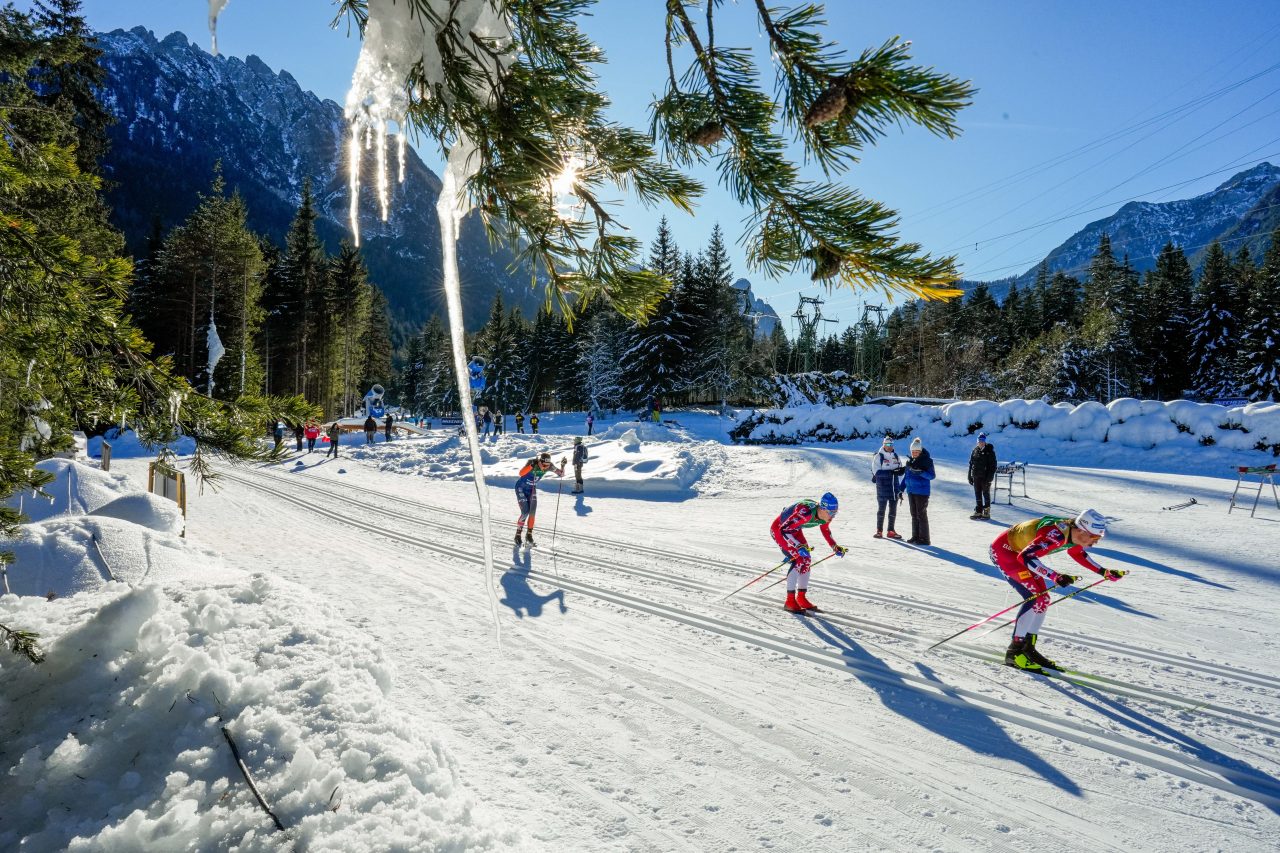
By the 5 kilometer mark, Klaebo had joined Krueger and Musgrave, forming a chase group that steadily gained ground on Amundsen. Though still over 30 seconds back at the halfway point of 7 kilometers, they worked efficiently together, taking turns drafting to conserve energy and maintain their lead over the following pack just 30 seconds behind them.
Over the next few kilometers, the dynamic shifted, with the chase group’s position relative to Amundsen fluctuating based on the course’s terrain. Between the 6.7 and 7.1 kilometer checkpoints, over the steepest section of the course, the group lost over 10 seconds to Amundsen but regained that margin quickly by the 8 kilometer mark. Amundsen continued to put time on Klaebo on the climbs, though lacked the collaboration and motivation that comes from head-to-head competition within a group to push through the descents and flatter terrain.
At the 10 kilometer mark, Klaebo attempted his characteristic breakaway performance and reduced his distance behind Amundsen to 17.7 seconds while gaining 6 seconds over Krueger and Musgrave. However, the effort was unsustainable, and by the 12.1 kilometer mark, the trio again worked together in Amundsen’s shadow.
The second chase pack contained Edvin Anger (SWE), Hugo Lapalus (FRA), Freidrich Moch (GER), Mathis Desloges (FRA), Mika Vermeulen (AUT), Andreas Fjorden Ree (NOR). The group was able to reel Klaebo and the rest of the first chase group in, now with eight skiers competing for the second and third podium positions by the 14 kilometer mark.
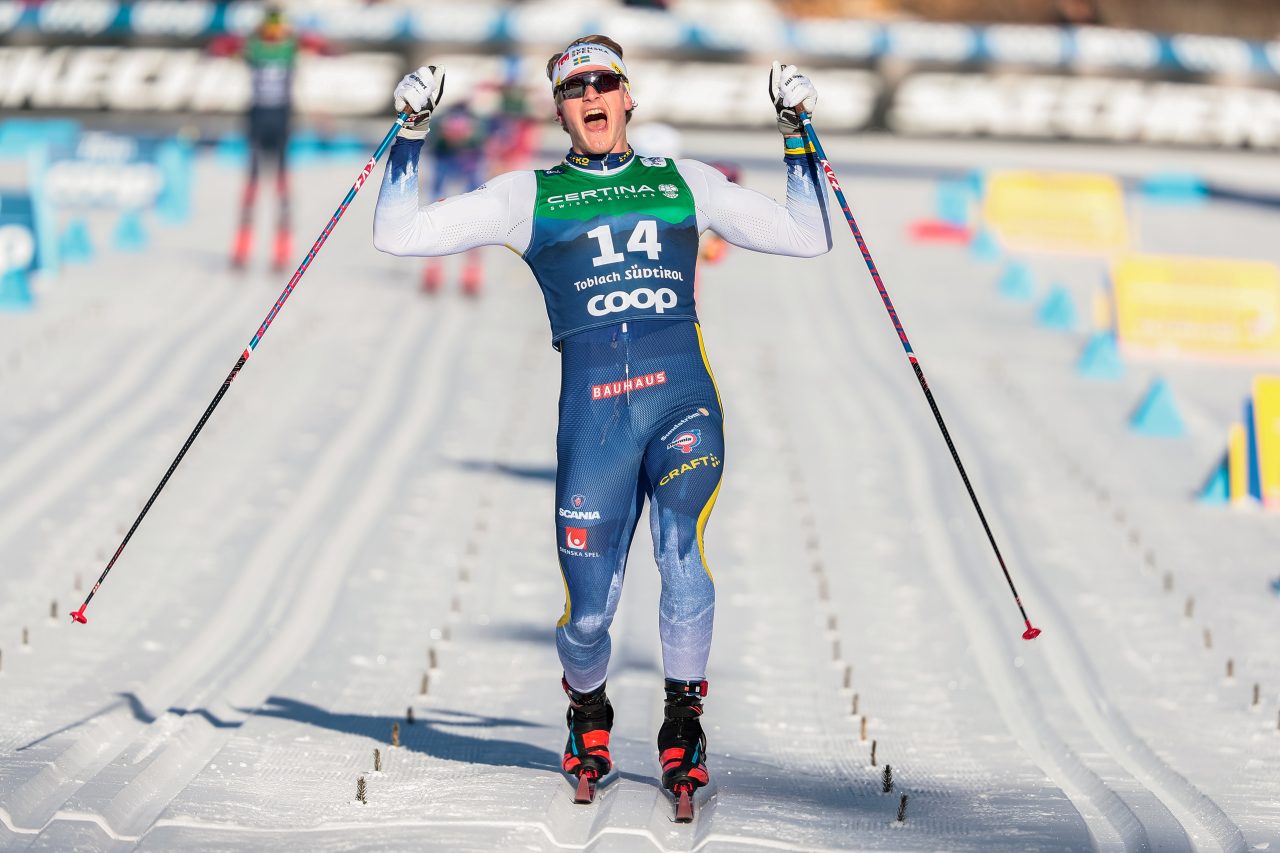
In the final kilometer, Anger made a move over the second to last hill, pushing over the top and positioning himself in the front of the chase pack heading into the stadium stretch. Klaebo edged on the gas in an attempt to follow, but was unable to match the pace set by Anger. While Klaebo extended his lead over the rest of the pack, Anger powered ahead to take second place, just 2.5 seconds behind Amundsen. Anger raced to earn the fastest time for the day, and earned his first-ever distance podium in an individual event. Klaebo crossed the line 5.3 seconds back in third, with the rest of the chase pack finishing only a few seconds behind him.
The pursuit format, heavily influenced by start order, may mask strong individual efforts in the results. Gus Schumacher (USA) climbed from 34th to 17th place in the results, making up over a minute on the leaders—more time than Klaebo himself regained—with the 3rd fastest time of the day.
As for Klaebo, while it wasn’t the victory he had hoped for, the result was enough to maintain his overall lead of the Tour. He will arrive in Val di Fiemme still adorned in the yellow bib, ready to defend his position as the competition continues.
2024/25 Tour de Ski overall standings (after Stage 4):
- Johannes Høsflot Klæbo (NOR) 1:59:21
- Edvin Anger (SWE) +0:36
- Harald Østberg Amundsen (NOR) +0:57
- Mika Vermeulen (AUT) +1:23
- Hugo Lapalus (FRA) +1:24
- Simen Hegstad Krüger (NOR) +1:29
- Erik Valnes (NOR) +1:41
- Andreas Fjorden Ree (NOR) +1:41
- Jan Thomas Jenssen (NOR) +1:43
- Gus Schumacher (USA) +1:45
Men’s Classic Pursuit Results
Tour de Ski Men’s Overall Standings
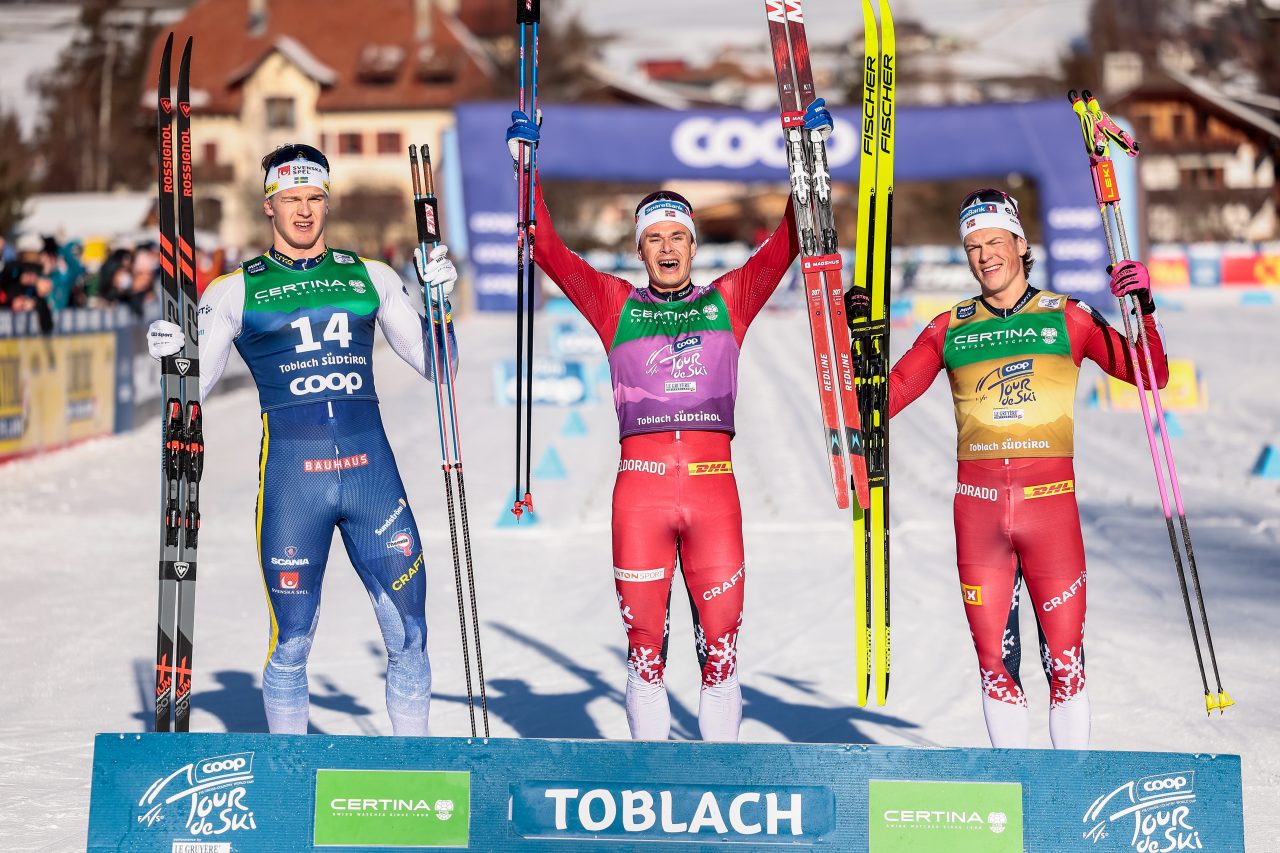
Kennedy Lange
Kennedy is a lifelong skier who competed on the Williams College ski team while earning a degree in Geosciences.



